Mathematical Influences
on the Design of Aircraft
The Basics
(Return to Previous Page)
The design
of winged aircraft must take into account the following forces:
Thrust
- The force providing
a method of moving the aircraft forward. For most small private
aircraft, this is usually provided via an internal combustion
engine that turns a propellar.
Drag - The force of the air (or other
fluid the aircraft is flying through) acting via friction on
the aircraft in resisting the forward motion of the aircraft.
Weight - The total mass of the aircraft,
occupants, fuel and baggage acted on by gravity.
Lift - The force provided by the wings
where through either differential pressure (Bernoulli) or by
air striking the wing (Newton), that results in the aircraft
being able to move opposite the direction of gravity (weight).
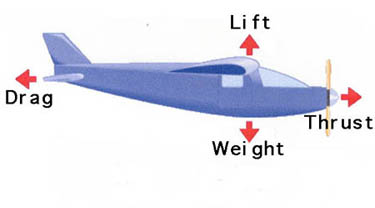
There has been much debate as to the validity
of Bernoulli vs. Newton in the process of determining the amount
of lift an aircraft will provide, given its design. Essentially,
most of the information concerning the lift a given wing provides
is done through actual testing and measurement of the actual wing,
given its airfoil design. This is graphed (see attached graph)
to determine what lift may be expected from a given size wing
with this particular airfoil design.
The calculation then becomes rather straightforward:
LIFT = Cl X 1/2 X rho
X V X V X A
Where: Cl is the lift coefficient taken from
the graph
rho is the air density
V is the air velocity
and A is the wing area.
This brings us to the design of the key elements
of the aircraft:
1. Wings (airfoil and area)
The wings and their basic shape affect
the way the plane gets it lift and performs in the air. As was
shown earlier, when we discussed lift, the wings shape determines
the amount of lift and is determined via actual testing of the
airfoil. Note that for most stunt planes and supersonic jets,
the wings are actually symmetric on the top and the bottom. This
means that the plane gets all its lift from the angle of attack
of the wing. This does not apply to the typical private aircraft,
as the cost involved with the complex flaps and slats schemes
is more than the fair weather pilot will bear.
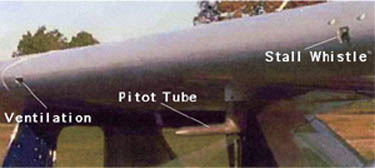
The angle of attack means the angle that
the wing presents to the oncoming air. This angle controls the
thickness of the slice of air the wing is cutting off. This angle
is controlled by other design elements associated with the wing
- i.e. the flaps and the slats. (discussed below.) The flaps
are located on the trailing edge of the wing. The slats are located
on the forward edge of the wing.
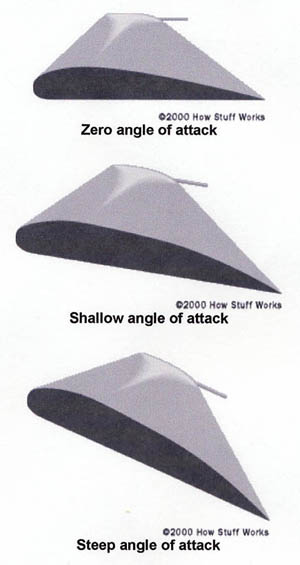
Another interesting design element that
can be used concerns a spinning cylinder. It would be expected
that a cylinder would not have any affect on lift. (note the
first diagram below). However, when the cylinder is rotated,
the surface of the cylinder drags the surrounding layer of air
around it. This will create a pressure differential between the
top and bottom surfaces, which deflects the airflow downward.
This is an example of the Magnus
Effect (also referred to as the Robins Effect). The reference
here leads to a good explanation of the mathematics behind this
effect. This also holds true for rotating spheres. Note that
again, the placement of rotating cylinders within wings of private
aircraft is cost prohibitive.
A side note, since this will apply to spheres,
note that a golf ball or a tennis ball which has backspin (due
to it being "undercut") will experience a Magnus force,
causing it to rise. (Note the second picture below). The longer
"hang time" of the spinning golf ball leads to longer
drives. In fact, experienced golfers play with somewhat softer
balls, which adhere more readily to the face of the club and
receive a larger angular momentum (and angular velocity). A less
experienced golfer will tend to slice such a ball, maiming innocent
bystanders (a feat accomplished by many presidential golfers).
Conversely, a tennis ball with a heavy topspin will "drop"
into the opponent's court
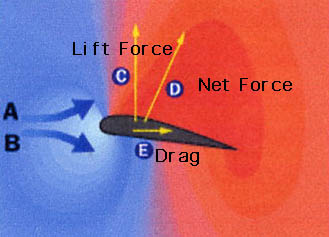
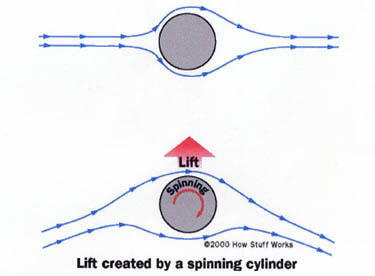
2. The Tail Section of the Plane

The tail section of the plane is the key
element for control of the aircraft. The two small wings on the
tail are referred to as horizontal and vertical stabilizers.
The horizontal stabilizer has two large flaps which are use primarily
for controling the nose up or nose down. These flaps are referred
to as elevators. The vertical stabilizer, with its flap, works
like a rudder and causes the nose of the plane to be redirected
left or right.
2. Flaps

A generic term used for any of the various
elevators or ailerons on the aircraft. When directly referred
to, these are the inner flaps on the main wing which control
the angle of attack and will cause the aircraft to lift up or
drop down. The design of the flap is inherent with the design
of the wing airfoil and is used to determine the lift provided
by the wing system.
3. Ailerons (near end of wings)
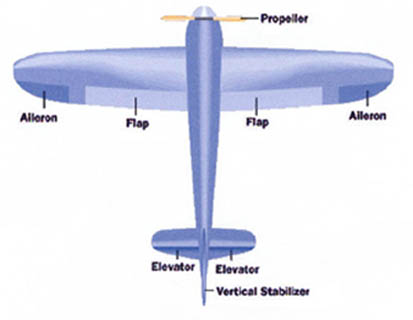
These are flaps on the end of the wings
that are used to cause the aircraft to turn. One aileron is up
with the other down to turn in the direction of the aileron that
is down. The aileron is also part of the wing system and is used
in determination of aircraft lift.
4. Slats

These are controlable areas on the leading
edge of the wing which affect the wing system's lift capability.
These are used only on takeoff and landings to provide additional
lift (or reduction in lift when landing). As in the flaps, these
change the overall angle of attack for the wing system. Slats
are not typically seen on smaller aircraft, due to the complexity
(read cost...) associated with deploying these devices.
5. Engine
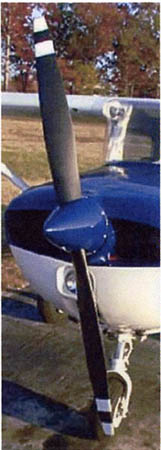
The first four elements are all related to
providing and controlling the lift. The last item is related to
providing and controlling the thrust. All of the items must be
examined to see how they contribute to drag and weight. As in
most designs, there is a balancing act to determine an optimum
set of characteristics for the aircraft.
For small private aircraft, the key parameters
are cost, efficiency, cost, reliability, cost, safety, cost, speed,
cost, size, cost, maintenance schedule and cost. When evaluating
an item for inclusion on the aircraft, additional weight and drag
will result in additional costs for a larger engine and subsequently
more expense in operation.
(Return to Previous Page)